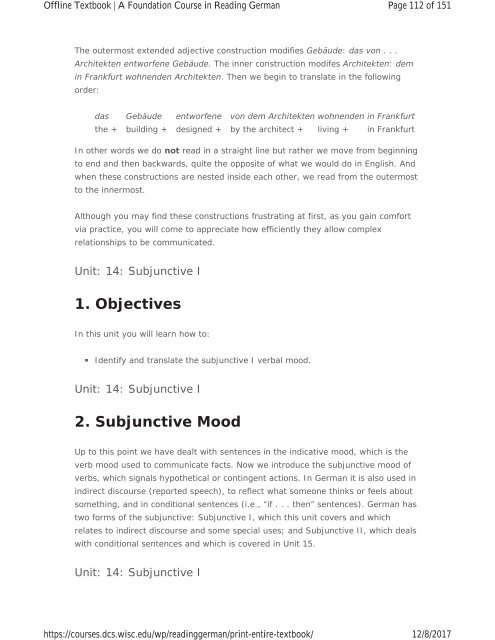A Foundation Course in Reading German, 2017a
A Foundation Course in Reading German, 2017a
A Foundation Course in Reading German, 2017a
You also want an ePaper? Increase the reach of your titles
YUMPU automatically turns print PDFs into web optimized ePapers that Google loves.
Offl<strong>in</strong>e Textbook | A <strong>Foundation</strong> <strong>Course</strong> <strong>in</strong> Read<strong>in</strong>g <strong>German</strong><br />
https://courses.dcs.wisc.edu/wp/read<strong>in</strong>ggerman/pr<strong>in</strong>t-entire-textbook/<br />
Page 112 of 151<br />
12/8/2017<br />
The outermost extended adjective construction modifies Gebäude: das von . . .<br />
Architekten entworfene Gebäude. The <strong>in</strong>ner construction modifes Architekten: dem<br />
<strong>in</strong> Frankfurt wohnenden Architekten. Then we beg<strong>in</strong> to translate <strong>in</strong> the follow<strong>in</strong>g<br />
order:<br />
das<br />
Gebäude<br />
entworfene<br />
von dem Architekten wohnenden <strong>in</strong> Frankfurt<br />
the +<br />
build<strong>in</strong>g +<br />
designed +<br />
by the architect +<br />
liv<strong>in</strong>g +<br />
<strong>in</strong> Frankfurt<br />
In other words we do not read <strong>in</strong> a straight l<strong>in</strong>e but rather we move from beg<strong>in</strong>n<strong>in</strong>g<br />
to end and then backwards, quite the opposite of what we would do <strong>in</strong> English. And<br />
when these constructions are nested <strong>in</strong>side each other, we read from the outermost<br />
to the <strong>in</strong>nermost.<br />
Although you may f<strong>in</strong>d these constructions frustrat<strong>in</strong>g at first, as you ga<strong>in</strong> comfort<br />
via practice, you will come to appreciate how efficiently they allow complex<br />
relationships to be communicated.<br />
Unit: 14: Subjunctive I<br />
1. Objectives<br />
In this unit you will learn how to:<br />
Identify and translate the subjunctive I verbal mood.<br />
Unit: 14: Subjunctive I<br />
2. Subjunctive Mood<br />
Up to this po<strong>in</strong>t we have dealt with sentences <strong>in</strong> the <strong>in</strong>dicative mood, which is the<br />
verb mood used to communicate facts. Now we <strong>in</strong>troduce the subjunctive mood of<br />
verbs, which signals hypothetical or cont<strong>in</strong>gent actions. In <strong>German</strong> it is also used <strong>in</strong><br />
<strong>in</strong>direct discourse (reported speech), to reflect what someone th<strong>in</strong>ks or feels about<br />
someth<strong>in</strong>g, and <strong>in</strong> conditional sentences (i.e., “if . . . then” sentences). <strong>German</strong> has<br />
two forms of the subjunctive: Subjunctive I, which this unit covers and which<br />
relates to <strong>in</strong>direct discourse and some special uses; and Subjunctive II, which deals<br />
with conditional sentences and which is covered <strong>in</strong> Unit 15.<br />
Unit: 14: Subjunctive I


















